Introduction
Many researchers define a project as a distinctive undertaking that tries to achieve a distinct purpose. A project, normally, has multifaceted but interconnected small projects within it. A project’s limitations include duration, budget, and scope. Researchers further stated that each project is unique, as it is unlikely to be repeated. Project objectives are determined by the parameters of duration, budgets, and scope (referred to as performance) (Gray & Larson 2008).
Duration, budgets, and scope have to be balanced for the most favourable outcome. Thus, duration, budgets, and scope are a triangle of objectives, referred to as “the magic triangle of project management”. If one is affected, the two other objectives will also be affected. However, the quality/performance objective is often considered paramount (Hay 2010).
Review of Project Management Methodologies
Project Cost
The cost of the project depends on the selected software and the properties of the hardware installed for the new system. The investment for the project will involve the cost of disposing of the current computers used by the accounting department. It will also include purchasing new computers, procuring the accounting software, and installation of the system to substitute for the existing procedures. Another cost driver is the training of the users of the new system for accounting and auditing processes.
Project Scope
The primary scope of the project is to install an automated computerized accounting system to operate the government’s accounting process. The main objective of the project is to provide an effective system to facilitate the accuracy and efficiency of accounting for transactions as well as financial information. The system needs to be user-friendly and supported by a centralized IT infrastructure. The system will be configured to ensure simplified posting of accounts payable and accounts receivable. The system should also eliminate the need for multiple postings in the books of accounts to maintain accounting records and comply with accounting principles.
The current project will necessitate the government to acquire new computers with more efficient processors and reliable memory capacities. Also, the project should include the installation of secure and reliable data storage and backup system and devices. The project will also incorporate training of the government’s staff to match their skills with the demands of both the new system and the accounting principles.
Team Organization
The team that will be in charge of this project includes key leaders in charge of all the departments that will be affected by the new system. A project manager who will be assisted will head the team by the current head of the IT department as a project assistant manager. A project management committee that will meet every week to review the progress of the project will make major decisions on the project. Overall, the project team will comprise four teams responsible for specific roles. These teams are the system development, the hardware installation, the accounting, and the training teams. A supervisor who will be a member of the project management committee will head each of these teams (Rossberg 2014).
Project Schedule
The project will be held in a period that will be determined by the government’s management since its implementation will disrupt the operations of the government’s accounting department (Johnson, Whittington & Scholes 2011). Project evaluation will be done weekly, but daily assessments will be carried out to review its progress. There will ensure there is no time gap between project pilot exercise and project rollout to avoid delays in the implementation schedule. The management will decide on the expected completion dates from three dates recommended by the project management committee (Westland 2007).
Network Diagram
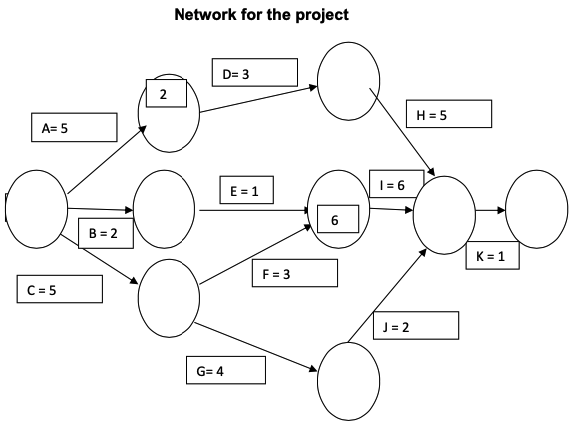
The following are the identified project activities represented by each letter in the
network above. Each activity will be implemented independently but in line with the schedule of the project (Schwalbe 2013).
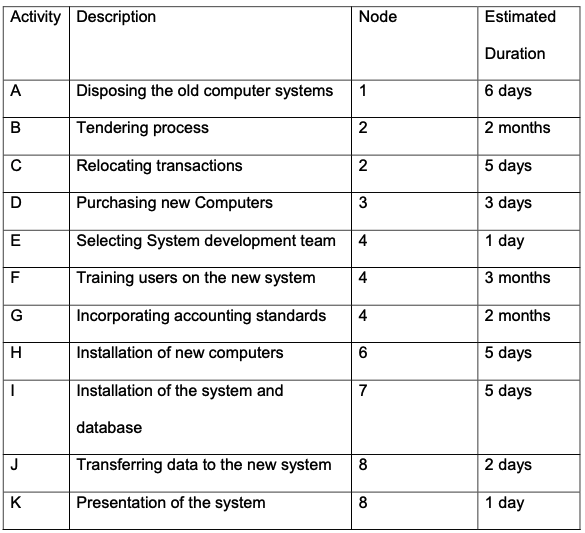
Identification of All the Paths of the Project
- A – D – H – K = 5 + 3 + 5 + 1 = 14
- B – E – I – K = 2 + 1 + 6 + 1 = 10
- C – F – I – K = 2 + 3 + 6 + 1 = 12
- C – G – J – K = 5 + 4 + 2 + 1 = 11
The project’s critical path is B-E-I -K and will take one year to complete. The shortest time it can take to complete the project is, therefore, one year (Kirkpatrick & Locke 1991).
Gantt Chart
The project’s Project Manager may find it quite useful to engage the use of a Gantt chart in managing complexity in cost and time (Vargas 2007). A Gantt chart is an intricate tool used for the management of interrelated tasks with different durations. When using a Gantt chart, the project manager assumes that the tasks are linear, and their durations can be determined beforehand with a high degree of precision. However, management should have duration estimates with the relevant possible contingencies (Ahrens & Chapman 2007).
A Gantt chart has several benefits to the project manager. First, it diagrammatically represents the whole project, which makes it easy for the project manager to identify the activities to complete first and clearly shows the relationships between tasks. Second, it shows the duration of a project. However, in as much as it may show the tasks clearly, it does not indicate dependencies among tasks and the project manager may not know from the Gantt chart how the delay of one task may affect another. For this purpose, the project manager will have to use the network diagrams. The figure below shows the Gantt chart for this project. It indicates the start times and durations for each activity. However, it does indicate the costs. The durations are indicated in days/months (Snyder 2010).
Project cost
Measuring performance is used to determine the success or failure of a project. The project is successful if it has been completed according to specifications and on eight times. However, for a long-term project such as the National IT Project, these criteria cannot be used to assess the entire project while it is still ongoing. However, they can be used to measure the performance of project tasks, which are an indicator of the eventual outcome of the project.
As the project parameters are time, cost, and performance, the first measurement parameter for the National IT Project is whether the subcontracts have been completed on time and within budget. In terms of performance, some aspects of the project can only be assessed when it is complete. Nevertheless, if quality control is done for each segment of the project as and when it is completed, the likelihood of the completed project meeting and /or exceeding performance requirements will be increased.
Project and Budget Control Charts
The project manager may use the Project and Budget Control Chart below (Johnson, Whittington & Scholes 2011).
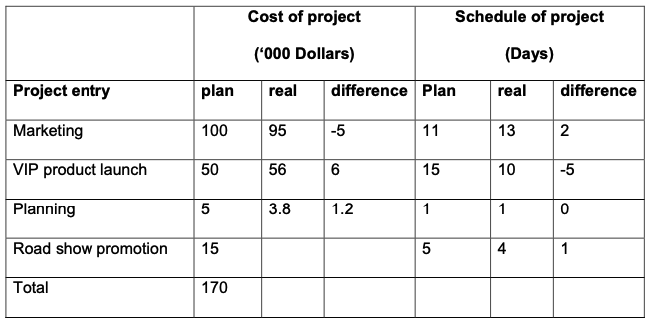
Project Communication
The management of the project will adopt several methods of passing information as well as tools of sharing data among the team members and other users involved. The management will print out a Gantt chart for the project to indicate progress and use a timescale to make the Gantt chart fit one page. The chart will then be pasted in a PowerPoint or printed on a slide for easy presentation.
The management will also print a “To-do List” information sheet for all the team members to ensure that everyone understands his or her role. Also, the project manager will prepare a “Who Does What” information sheet that will determine all the roles and people responsible for them. Hence, the team will facilitate coordination among the team players. The continuous update will be done to the communication plan as appropriate and will be reviewed during the weekly status meetings. However, the management of the government and the Project Manager will approve all the changes that should be made to the plan during the meetings.
In the National IT Project, project change is authorized through change orders. The project manager keeps track of them and reports on them to stakeholders at all levels of the project. Changes are often caused by a changes in the client’s requirements, changes in local authority regulations, correcting errors in the specifications, unavailability of specific materials or equipment, and new technology. Minimizing misunderstanding due to change is the responsibility of the project manager. Requests for change should be detailed, including the time and cost estimates for making the change, and the period for responding to the change request.
In the National IT Project, the change procedure is the responsibility of the project manager. As far as reasonably possible under the contract agreements, subcontractors are supposed to fulfil the terms and conditions of their contracts. If a subcontractor is unable to do so, they are required to communicate with the project manager, who will then decide what level of change (if any) can be allowed from the original requirements without compromising project schedule, budget or quality.
The following is a model communication matrix (Manzoor, 2012).
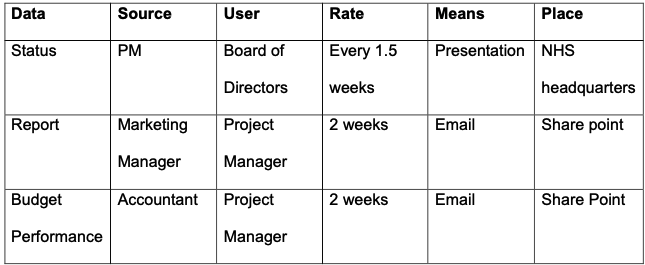
Risk Management Plan
Risk assessment of the project will be defined in terms of the probability of occurrence of risky events (Hitt & Hoslisson 2008). Concerning the impact of the risks, the negative cost of each one will eventually be regarded as an impact of the risky event on the project? Risk analysis will, therefore, involve the increase in the impact of the speculated risk events and their probability to occur as well as their sensitivity to change. Risk response will be determined by the findings of risk analysis of every event (Castells 2011).
The response will determine appropriate actions to be taken if the speculated events occur. The response will be coordinated through a risk response table that will include a summary of a contingency plan for all the risks (Holliday 2007). Designing an automated system will encounter several risks. For example, the basic probability of equipment failure to more complex issues, including the threat of the wrong choice of information management strategy. The risks might lead to confusion in the data and the ultimate failure of the venture. However, an efficient risk management plan will ensure coordination (Chase & Aquilano 2006). In this project, the highest risk is a technical risk.
Risks Register
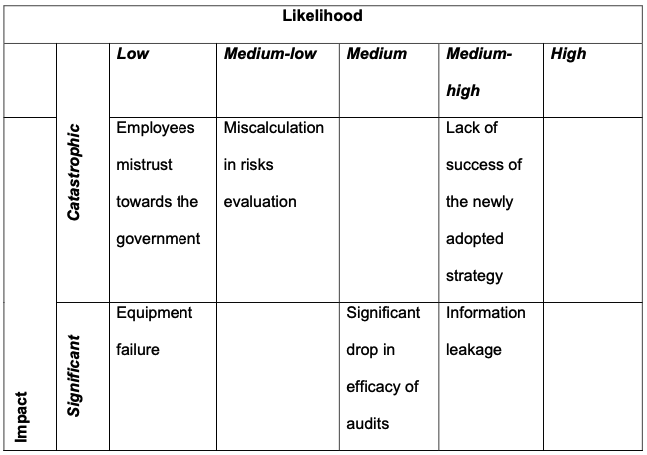
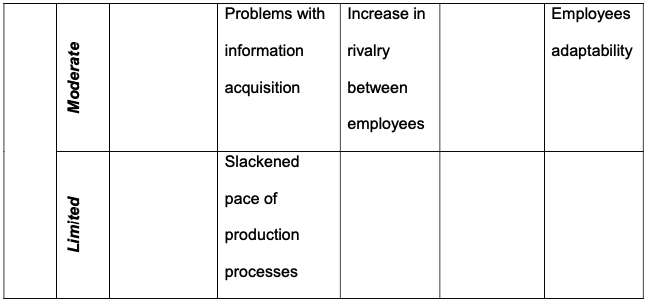
Sensitivity Analysis

Risk Response Plan
The risk response plan includes the following recommendations to mitigate risks.

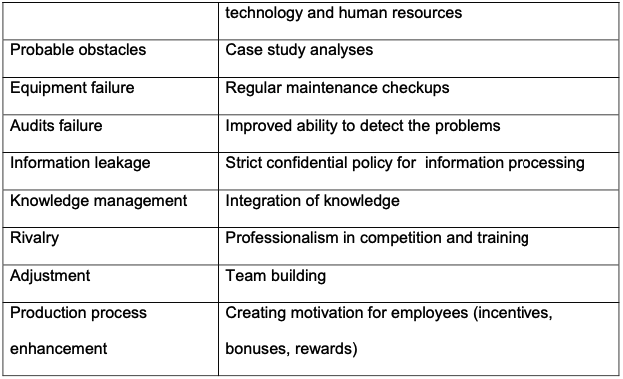
Project review
For this project, the most appropriate method of reporting the project should be the linear method. In this method, project members will report to the project manager over their respective tasks. The project manager will compile this report to help determine the level of success of the project. The project manager will then prepare a detailed report and give it to the projects coordinator. The project coordinator will verify this report and then send it to the top management. The top management will approve and make a publication of the report at a preferred time.
In the process of implementing a project, problems would always rise. When such cases arise, the management is forced to come up with a solution that will help in dealing with the problem. One such problem that can arise when implementing this project is when employees start giving fake reports to please the management.
The latter is quite dangerous because of the hope and subsequent responsibility and finance that will be committed to the project will be lost. To deal with this problem, the management should conduct regular evaluations of the project and discourage unfaithfulness among employees. Another problem may arise when there is lack of cooperation or proper coordination of the employees who form the team implementing the project. Therefore, there will be an ongoing review of work done as it progresses.
Supplier Management
The project management committee will float tenders to interested suppliers and receive their offers according to the government’s procurement procedures (Barney 2002). After assessing the received tenders, the project management committee will recommend the best suppliers to the procurement department to select the most appropriate one among them. The selected supplier will be contracted to supply the government with the ordered software, computer hardware and system development services. In such a way, the project management team will acquire the services of the best supplier while maintaining the government’s procurement standards.
Reference List
Ahrens, T & Chapman, C 2007, Management Accounting as Practice, Accounting, Organizations and Society, vol. 32 no. 1, pp 1-27.
Barney, J 2002, Gaining and Sustaining Competitive Advantage, Pearson, Upper Saddle River, NJ.
Castells, M 2011, The Rise of the Network Society: The Information Age: Economy, Society and Culture, John Wiley & Sons, New York, NY.
Chase, B & Aquilano, N 2006, Operations Management for Competitive Advantage, McGraw Irwin, New York.
Gray, C & Larson, E 2008, Project management: The managerial process, McGraw–Hill Education, Singapore.
Hay, I 2010, Qualitative Research Methods in Human Geography, London, Oxford University Press.
Hitt, M & Hoslisson, R 2008, Strategic Management Competitiveness and Globalization, Thomson, London.
Holliday, A. 2007, ‘Doing and Writing Qualitative Research’, Journal of Geography, Vol. 65, no. 2, pp. 14-16.
Johnson, G, Whittington C & Scholes, K 2011, Exploring Strategy Text & Cases, FT Prentice Hall, New York.
Kirkpatrick, S, & Locke, E, 1991, ‘Leadership: do traits matter?’, Academy of Management Executive, vol. 5 no. 2, pp 48-60.
Manzoor, Q 2012, ‘Impact of employees motivation on organizational effectiveness’, Business Management and Strategy, vol. 3, no. 1, pp. 1-12.
Project Part One 16 Rossberg, J 2014, Beginning application lifecycle management, Springer, Berkeley, CA.
Schwalbe, K 2006, Introduction to project management, Thomson Course Technology, Boston.
Schwalbe, K 2013, Information technology project management, Cengage Learning, Boston.
Snyder, C 2010, A user’s manual to the PMBOK guide, Wiley, Hoboken, NJ. Stonebumer, G, Goguen, A & Feringa, A 2002, Risk management guide for information technology systems, McGraw-Hill, London.
Vargas, R 2007, Practical guide to project planning, CRC Press, New York, NY. Westland, J 2007, The project management lifecycle, Kogan Page, London.